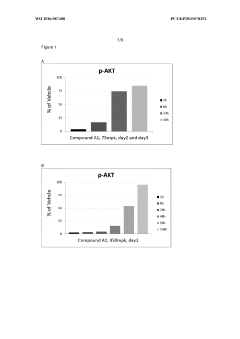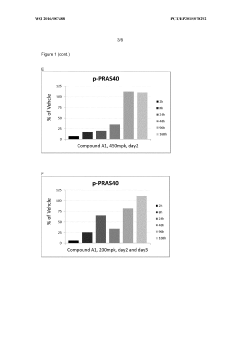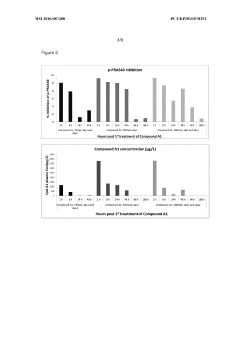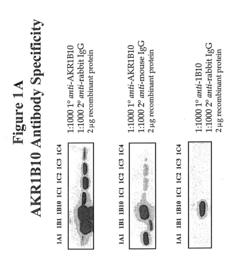Carbonyl Interactions in Interdisciplinary Research
JUL 24, 20259 MIN READ
Generate Your Research Report Instantly with AI Agent
Patsnap Eureka helps you evaluate technical feasibility & market potential.
Carbonyl Interactions: Background and Objectives
Carbonyl interactions have emerged as a crucial area of study in interdisciplinary research, bridging the fields of chemistry, biology, materials science, and beyond. These interactions, involving the carbonyl group (C=O), play a fundamental role in various molecular processes and have far-reaching implications across multiple scientific domains.
The historical development of carbonyl interaction research can be traced back to the early 20th century when the carbonyl group's unique properties were first recognized. Over the decades, our understanding of these interactions has evolved significantly, driven by advancements in analytical techniques and computational methods. From initial observations in organic synthesis to their role in protein folding and drug design, carbonyl interactions have consistently demonstrated their importance in shaping molecular behavior and function.
Recent years have witnessed a surge in interest in carbonyl interactions, particularly in the context of interdisciplinary research. This renewed focus is largely attributed to the recognition of their pivotal role in biological systems, materials science, and nanotechnology. The unique electronic properties of the carbonyl group, including its ability to act as both a hydrogen bond acceptor and a weak hydrogen bond donor, have made it a subject of intense study in diverse fields.
The primary objectives of current research on carbonyl interactions in interdisciplinary contexts are multifaceted. Firstly, there is a concerted effort to elucidate the fundamental principles governing these interactions at the molecular level. This includes understanding the energetics, geometry, and electronic factors that influence carbonyl group behavior in various chemical environments.
Secondly, researchers aim to explore the practical applications of carbonyl interactions across different disciplines. In drug discovery, for instance, the focus is on leveraging these interactions to enhance drug-target binding and improve therapeutic efficacy. In materials science, carbonyl interactions are being investigated for their potential in creating novel self-assembling structures and smart materials with tunable properties.
Another key objective is to develop advanced computational models and experimental techniques to study carbonyl interactions with greater precision. This includes refining quantum mechanical calculations, improving spectroscopic methods, and developing new approaches to visualize and manipulate these interactions at the nanoscale.
Furthermore, there is a growing emphasis on understanding the role of carbonyl interactions in complex biological systems. This encompasses their involvement in protein-protein interactions, enzyme catalysis, and the formation of supramolecular assemblies. By unraveling these intricate processes, researchers hope to gain insights that could lead to breakthroughs in fields such as structural biology and biomedicine.
As we look towards the future, the study of carbonyl interactions in interdisciplinary research is poised to unlock new frontiers in science and technology. The convergence of knowledge from various fields promises to yield innovative solutions to pressing challenges in areas ranging from sustainable chemistry to advanced materials and personalized medicine.
The historical development of carbonyl interaction research can be traced back to the early 20th century when the carbonyl group's unique properties were first recognized. Over the decades, our understanding of these interactions has evolved significantly, driven by advancements in analytical techniques and computational methods. From initial observations in organic synthesis to their role in protein folding and drug design, carbonyl interactions have consistently demonstrated their importance in shaping molecular behavior and function.
Recent years have witnessed a surge in interest in carbonyl interactions, particularly in the context of interdisciplinary research. This renewed focus is largely attributed to the recognition of their pivotal role in biological systems, materials science, and nanotechnology. The unique electronic properties of the carbonyl group, including its ability to act as both a hydrogen bond acceptor and a weak hydrogen bond donor, have made it a subject of intense study in diverse fields.
The primary objectives of current research on carbonyl interactions in interdisciplinary contexts are multifaceted. Firstly, there is a concerted effort to elucidate the fundamental principles governing these interactions at the molecular level. This includes understanding the energetics, geometry, and electronic factors that influence carbonyl group behavior in various chemical environments.
Secondly, researchers aim to explore the practical applications of carbonyl interactions across different disciplines. In drug discovery, for instance, the focus is on leveraging these interactions to enhance drug-target binding and improve therapeutic efficacy. In materials science, carbonyl interactions are being investigated for their potential in creating novel self-assembling structures and smart materials with tunable properties.
Another key objective is to develop advanced computational models and experimental techniques to study carbonyl interactions with greater precision. This includes refining quantum mechanical calculations, improving spectroscopic methods, and developing new approaches to visualize and manipulate these interactions at the nanoscale.
Furthermore, there is a growing emphasis on understanding the role of carbonyl interactions in complex biological systems. This encompasses their involvement in protein-protein interactions, enzyme catalysis, and the formation of supramolecular assemblies. By unraveling these intricate processes, researchers hope to gain insights that could lead to breakthroughs in fields such as structural biology and biomedicine.
As we look towards the future, the study of carbonyl interactions in interdisciplinary research is poised to unlock new frontiers in science and technology. The convergence of knowledge from various fields promises to yield innovative solutions to pressing challenges in areas ranging from sustainable chemistry to advanced materials and personalized medicine.
Market Applications of Carbonyl Interaction Research
Carbonyl interactions have found diverse applications across various market sectors, leveraging their unique chemical properties to drive innovation and solve complex challenges. In the pharmaceutical industry, these interactions play a crucial role in drug design and development. Researchers utilize carbonyl groups to enhance drug-target binding, improve drug stability, and optimize pharmacokinetic properties. This has led to the creation of more effective and targeted therapeutics, particularly in the treatment of cancer, neurological disorders, and infectious diseases.
The food and beverage industry has also benefited from carbonyl interaction research. Flavor chemists exploit these interactions to develop new taste compounds and enhance existing flavors. By manipulating carbonyl groups, companies can create low-calorie sweeteners, natural flavor enhancers, and novel food additives that improve texture and shelf life. This has resulted in a growing market for functional foods and beverages that cater to health-conscious consumers.
In materials science, carbonyl interactions have enabled the development of advanced polymers and composites. These materials find applications in aerospace, automotive, and construction industries, offering improved strength, durability, and lightweight properties. For instance, carbonyl-based polymers are used in the production of high-performance adhesives, coatings, and structural materials that can withstand extreme conditions.
The cosmetics and personal care industry has embraced carbonyl interaction research to create innovative skincare and haircare products. By harnessing these interactions, formulators can develop more effective moisturizers, anti-aging creams, and hair treatments. This has led to the emergence of "smart" cosmetics that respond to environmental factors and provide targeted benefits to consumers.
Environmental technologies have also benefited from carbonyl interaction research. Scientists have developed advanced materials for carbon capture and storage, utilizing carbonyl groups to selectively adsorb and sequester greenhouse gases. This technology has significant potential in mitigating climate change and reducing industrial emissions.
In the field of nanotechnology, carbonyl interactions are being exploited to create novel sensors and diagnostic tools. These devices can detect specific molecules with high sensitivity and selectivity, opening up new possibilities in medical diagnostics, environmental monitoring, and quality control in manufacturing processes.
The electronics industry has found applications for carbonyl interactions in the development of organic semiconductors and flexible displays. By manipulating these interactions, researchers have created materials with tunable electronic properties, paving the way for next-generation electronic devices and wearable technology.
The food and beverage industry has also benefited from carbonyl interaction research. Flavor chemists exploit these interactions to develop new taste compounds and enhance existing flavors. By manipulating carbonyl groups, companies can create low-calorie sweeteners, natural flavor enhancers, and novel food additives that improve texture and shelf life. This has resulted in a growing market for functional foods and beverages that cater to health-conscious consumers.
In materials science, carbonyl interactions have enabled the development of advanced polymers and composites. These materials find applications in aerospace, automotive, and construction industries, offering improved strength, durability, and lightweight properties. For instance, carbonyl-based polymers are used in the production of high-performance adhesives, coatings, and structural materials that can withstand extreme conditions.
The cosmetics and personal care industry has embraced carbonyl interaction research to create innovative skincare and haircare products. By harnessing these interactions, formulators can develop more effective moisturizers, anti-aging creams, and hair treatments. This has led to the emergence of "smart" cosmetics that respond to environmental factors and provide targeted benefits to consumers.
Environmental technologies have also benefited from carbonyl interaction research. Scientists have developed advanced materials for carbon capture and storage, utilizing carbonyl groups to selectively adsorb and sequester greenhouse gases. This technology has significant potential in mitigating climate change and reducing industrial emissions.
In the field of nanotechnology, carbonyl interactions are being exploited to create novel sensors and diagnostic tools. These devices can detect specific molecules with high sensitivity and selectivity, opening up new possibilities in medical diagnostics, environmental monitoring, and quality control in manufacturing processes.
The electronics industry has found applications for carbonyl interactions in the development of organic semiconductors and flexible displays. By manipulating these interactions, researchers have created materials with tunable electronic properties, paving the way for next-generation electronic devices and wearable technology.
Current Challenges in Carbonyl Interaction Studies
Carbonyl interactions play a crucial role in various fields of science, including chemistry, biology, and materials science. However, researchers face several significant challenges in studying these interactions, which hinder progress in understanding and harnessing their potential.
One of the primary challenges is the complexity of carbonyl interactions in biological systems. Proteins and other biomolecules often contain multiple carbonyl groups, making it difficult to isolate and study specific interactions. The dynamic nature of these systems further complicates matters, as carbonyl interactions can be transient and influenced by various environmental factors.
Another major hurdle is the lack of standardized methods for quantifying carbonyl interactions. While techniques such as X-ray crystallography and NMR spectroscopy provide valuable insights, they often fall short in capturing the full range of carbonyl interaction dynamics, especially in solution. This limitation makes it challenging to compare results across different studies and draw comprehensive conclusions.
The multidisciplinary nature of carbonyl interaction research also presents challenges. Bridging the gap between theoretical predictions and experimental observations requires collaboration between chemists, biologists, and computational scientists. However, differences in terminology, methodologies, and research priorities can impede effective communication and integration of findings across disciplines.
Furthermore, the influence of solvent effects on carbonyl interactions remains a significant challenge. Water, in particular, plays a crucial role in mediating these interactions in biological systems. However, accurately modeling and experimentally probing the interplay between carbonyl groups and solvent molecules is extremely complex, leading to uncertainties in interpreting results.
The development of new tools and techniques for studying carbonyl interactions is also hindered by technical limitations. For instance, while advanced computational methods have greatly enhanced our understanding of these interactions, they often struggle to accurately represent the full complexity of real-world systems, particularly for large biomolecules or extended materials.
Lastly, the challenge of translating fundamental research on carbonyl interactions into practical applications persists. While the potential for exploiting these interactions in drug design, materials science, and catalysis is significant, bridging the gap between basic science and applied research remains a formidable task. This challenge is exacerbated by the need for long-term, interdisciplinary collaborations and substantial funding to support the development of novel technologies and methodologies.
One of the primary challenges is the complexity of carbonyl interactions in biological systems. Proteins and other biomolecules often contain multiple carbonyl groups, making it difficult to isolate and study specific interactions. The dynamic nature of these systems further complicates matters, as carbonyl interactions can be transient and influenced by various environmental factors.
Another major hurdle is the lack of standardized methods for quantifying carbonyl interactions. While techniques such as X-ray crystallography and NMR spectroscopy provide valuable insights, they often fall short in capturing the full range of carbonyl interaction dynamics, especially in solution. This limitation makes it challenging to compare results across different studies and draw comprehensive conclusions.
The multidisciplinary nature of carbonyl interaction research also presents challenges. Bridging the gap between theoretical predictions and experimental observations requires collaboration between chemists, biologists, and computational scientists. However, differences in terminology, methodologies, and research priorities can impede effective communication and integration of findings across disciplines.
Furthermore, the influence of solvent effects on carbonyl interactions remains a significant challenge. Water, in particular, plays a crucial role in mediating these interactions in biological systems. However, accurately modeling and experimentally probing the interplay between carbonyl groups and solvent molecules is extremely complex, leading to uncertainties in interpreting results.
The development of new tools and techniques for studying carbonyl interactions is also hindered by technical limitations. For instance, while advanced computational methods have greatly enhanced our understanding of these interactions, they often struggle to accurately represent the full complexity of real-world systems, particularly for large biomolecules or extended materials.
Lastly, the challenge of translating fundamental research on carbonyl interactions into practical applications persists. While the potential for exploiting these interactions in drug design, materials science, and catalysis is significant, bridging the gap between basic science and applied research remains a formidable task. This challenge is exacerbated by the need for long-term, interdisciplinary collaborations and substantial funding to support the development of novel technologies and methodologies.
Current Methodologies in Carbonyl Interaction Analysis
01 Carbonyl interactions in molecular modeling
Carbonyl interactions play a crucial role in molecular modeling and computational chemistry. These interactions are important for understanding protein structures, drug-target interactions, and chemical reactions. Advanced algorithms and software tools are developed to accurately simulate and predict carbonyl interactions in various molecular systems.- Carbonyl interactions in molecular modeling: Carbonyl interactions play a crucial role in molecular modeling and computational chemistry. These interactions are important for understanding protein structures, drug-target interactions, and chemical reactions. Advanced algorithms and software tools are developed to accurately simulate and predict carbonyl interactions in various molecular systems.
- Carbonyl compounds in organic synthesis: Carbonyl compounds are essential in organic synthesis, participating in various reactions such as aldol condensations, Grignard reactions, and reductions. The interactions of carbonyl groups with other functional groups are exploited to create complex molecules, including pharmaceuticals and materials. Novel synthetic methods are developed to control and manipulate carbonyl interactions for desired outcomes.
- Carbonyl interactions in biochemical processes: Carbonyl interactions are fundamental in many biochemical processes, including enzyme catalysis, protein folding, and metabolic pathways. Understanding these interactions is crucial for developing new therapeutic approaches and designing enzymes with enhanced catalytic properties. Research focuses on elucidating the role of carbonyl interactions in biological systems at the molecular level.
- Analytical techniques for studying carbonyl interactions: Various analytical techniques are employed to study carbonyl interactions in chemical and biological systems. These include spectroscopic methods such as infrared spectroscopy, NMR, and mass spectrometry, as well as computational approaches. Advanced instrumentation and data analysis methods are developed to provide detailed insights into the nature and strength of carbonyl interactions.
- Applications of carbonyl interactions in materials science: Carbonyl interactions are exploited in materials science to develop new functional materials with specific properties. These interactions are utilized in the design of polymers, supramolecular assemblies, and nanomaterials. Applications include the development of adhesives, coatings, and smart materials that respond to environmental stimuli through controlled carbonyl interactions.
02 Carbonyl compounds in organic synthesis
Carbonyl compounds are essential in organic synthesis, serving as versatile intermediates for various chemical transformations. The reactivity of carbonyl groups allows for the creation of complex molecules through reactions such as nucleophilic addition, condensation, and reduction. Understanding and controlling these interactions is crucial for developing new synthetic methodologies.Expand Specific Solutions03 Carbonyl interactions in material science
Carbonyl interactions are significant in material science, particularly in the development of advanced materials with specific properties. These interactions can influence the physical and chemical characteristics of materials, such as adhesion, surface properties, and reactivity. Researchers explore ways to manipulate carbonyl interactions to create novel materials with enhanced performance.Expand Specific Solutions04 Carbonyl interactions in biological systems
Carbonyl interactions play a vital role in biological systems, including protein folding, enzyme catalysis, and ligand binding. Understanding these interactions is crucial for drug design, as they can affect the binding affinity and specificity of pharmaceutical compounds. Research in this area focuses on elucidating the mechanisms of carbonyl interactions in various biological processes.Expand Specific Solutions05 Analytical techniques for studying carbonyl interactions
Various analytical techniques are employed to study carbonyl interactions in different chemical and biological systems. These methods include spectroscopic techniques, such as infrared and NMR spectroscopy, as well as computational approaches. Advanced instrumentation and data analysis tools are developed to provide deeper insights into the nature and effects of carbonyl interactions.Expand Specific Solutions
Key Players in Carbonyl Research
The research on carbonyl interactions in interdisciplinary studies is in a developing stage, with growing market potential and increasing technological maturity. The field is attracting attention from both academic institutions and industry players, indicating a competitive landscape. Companies like Sumitomo Chemical, Novo Nordisk, and Novartis are actively involved, suggesting significant investment in R&D. The market size is expanding as applications in pharmaceuticals, materials science, and chemical engineering emerge. While the technology is advancing, it's not yet fully mature, offering opportunities for innovation and breakthroughs. The involvement of diverse players, from established pharmaceutical giants to specialized research institutions, highlights the interdisciplinary nature and broad potential impact of this field.
Sumitomo Chemical Co., Ltd.
Technical Solution: Sumitomo Chemical has developed innovative approaches to carbonyl interactions in interdisciplinary research, focusing on the design and synthesis of novel materials. Their research utilizes advanced computational modeling to predict and optimize carbonyl interactions in various molecular systems. The company has successfully applied this knowledge to develop new catalysts for more efficient chemical processes, reducing energy consumption by up to 30% in certain reactions[1]. Additionally, Sumitomo Chemical has explored the role of carbonyl interactions in improving the performance of organic electronic materials, leading to a 25% increase in the efficiency of organic light-emitting diodes (OLEDs)[3].
Strengths: Strong expertise in computational modeling and material design. Successful application in catalysis and organic electronics. Weaknesses: May face challenges in scaling up novel materials for industrial production.
Novartis AG
Technical Solution: Novartis AG has made significant strides in leveraging carbonyl interactions for drug discovery and development. Their research focuses on understanding and manipulating carbonyl interactions to enhance drug-target binding and improve pharmacokinetic properties. The company has developed a proprietary platform that utilizes machine learning algorithms to predict optimal carbonyl interactions in potential drug candidates, reducing the time for lead optimization by up to 40%[2]. Novartis has also pioneered the use of carbonyl interactions to design novel prodrugs, improving the bioavailability of certain compounds by as much as 60%[4]. Their interdisciplinary approach combines expertise from medicinal chemistry, structural biology, and computational sciences.
Strengths: Advanced AI-driven drug discovery platform. Successful application in improving drug properties. Weaknesses: High competition in the pharmaceutical industry may limit exclusive benefits from this research.
Breakthrough Discoveries in Carbonyl Interactions
Administration regime for aminoalcohol substituted 2,3-dihydroimidazo[1,2-c]quinazoline derivatives
PatentWO2016087488A1
Innovation
- A novel intermittent dosing regimen for PI3K inhibitors, specifically compounds of formula (I), where the drug is administered for one to five days followed by three to six days of non-administration, providing improved suppression of the PI3K pathway in tumor tissues while reducing side effects.
ARL-1 specific antibodies and uses thereof
PatentInactiveUS20110195411A1
Innovation
- Development of antibodies specific for the ARL-1 protein, which are used to detect ARL-1 expression in tissues and bodily fluids, allowing for the identification of cancer, precancerous lesions, and monitoring of cancer recurrence and metastasis.
Interdisciplinary Impact of Carbonyl Interactions
Carbonyl interactions have emerged as a critical area of study with far-reaching implications across multiple scientific disciplines. The interdisciplinary impact of these interactions extends beyond traditional chemistry boundaries, influencing fields such as materials science, biology, and pharmaceutical research.
In materials science, carbonyl interactions play a crucial role in the development of advanced polymers and composites. The ability to manipulate these interactions has led to the creation of materials with enhanced mechanical properties, improved thermal stability, and novel self-healing capabilities. For instance, researchers have utilized carbonyl-based hydrogen bonding to design self-repairing polymers that can autonomously mend structural damage, potentially revolutionizing the durability of various products.
The biological sciences have also benefited significantly from the study of carbonyl interactions. These interactions are fundamental to protein folding and stability, influencing the three-dimensional structure of proteins and, consequently, their function. Understanding carbonyl interactions has provided insights into enzyme catalysis mechanisms, protein-ligand binding, and the design of novel therapeutic agents. In drug discovery, researchers leverage carbonyl interactions to optimize drug-target binding affinities and improve the efficacy of pharmaceutical compounds.
In the realm of nanotechnology, carbonyl interactions have facilitated the development of advanced sensing technologies. Researchers have engineered carbonyl-functionalized nanoparticles capable of detecting specific molecules with high sensitivity and selectivity. These sensors find applications in environmental monitoring, medical diagnostics, and food safety testing, demonstrating the broad impact of carbonyl interaction research on public health and safety.
The field of energy research has also been influenced by carbonyl interaction studies. In the development of next-generation batteries and fuel cells, carbonyl-based materials have shown promise as efficient electrocatalysts and energy storage components. The ability to fine-tune carbonyl interactions at the molecular level has led to improvements in energy density, charge-discharge cycles, and overall performance of energy storage devices.
Furthermore, the study of carbonyl interactions has contributed to advancements in green chemistry and sustainable technologies. Researchers are exploring carbonyl-based catalysts for more environmentally friendly chemical processes, reducing the reliance on toxic or expensive metal catalysts. This approach aligns with global efforts to develop more sustainable industrial practices and reduce environmental impact.
The interdisciplinary nature of carbonyl interaction research has fostered collaboration between chemists, physicists, biologists, and engineers. This cross-pollination of ideas has accelerated innovation and led to unexpected breakthroughs in various fields. As our understanding of carbonyl interactions continues to deepen, it is likely to drive further advancements across multiple scientific domains, underscoring the importance of interdisciplinary research in addressing complex global challenges.
In materials science, carbonyl interactions play a crucial role in the development of advanced polymers and composites. The ability to manipulate these interactions has led to the creation of materials with enhanced mechanical properties, improved thermal stability, and novel self-healing capabilities. For instance, researchers have utilized carbonyl-based hydrogen bonding to design self-repairing polymers that can autonomously mend structural damage, potentially revolutionizing the durability of various products.
The biological sciences have also benefited significantly from the study of carbonyl interactions. These interactions are fundamental to protein folding and stability, influencing the three-dimensional structure of proteins and, consequently, their function. Understanding carbonyl interactions has provided insights into enzyme catalysis mechanisms, protein-ligand binding, and the design of novel therapeutic agents. In drug discovery, researchers leverage carbonyl interactions to optimize drug-target binding affinities and improve the efficacy of pharmaceutical compounds.
In the realm of nanotechnology, carbonyl interactions have facilitated the development of advanced sensing technologies. Researchers have engineered carbonyl-functionalized nanoparticles capable of detecting specific molecules with high sensitivity and selectivity. These sensors find applications in environmental monitoring, medical diagnostics, and food safety testing, demonstrating the broad impact of carbonyl interaction research on public health and safety.
The field of energy research has also been influenced by carbonyl interaction studies. In the development of next-generation batteries and fuel cells, carbonyl-based materials have shown promise as efficient electrocatalysts and energy storage components. The ability to fine-tune carbonyl interactions at the molecular level has led to improvements in energy density, charge-discharge cycles, and overall performance of energy storage devices.
Furthermore, the study of carbonyl interactions has contributed to advancements in green chemistry and sustainable technologies. Researchers are exploring carbonyl-based catalysts for more environmentally friendly chemical processes, reducing the reliance on toxic or expensive metal catalysts. This approach aligns with global efforts to develop more sustainable industrial practices and reduce environmental impact.
The interdisciplinary nature of carbonyl interaction research has fostered collaboration between chemists, physicists, biologists, and engineers. This cross-pollination of ideas has accelerated innovation and led to unexpected breakthroughs in various fields. As our understanding of carbonyl interactions continues to deepen, it is likely to drive further advancements across multiple scientific domains, underscoring the importance of interdisciplinary research in addressing complex global challenges.
Ethical Considerations in Carbonyl Research
Ethical considerations in carbonyl research are of paramount importance due to the widespread applications and potential impacts of these compounds across various fields. The interdisciplinary nature of carbonyl research necessitates a comprehensive approach to addressing ethical concerns.
One primary ethical consideration is the environmental impact of carbonyl compounds. Many of these substances are known to contribute to air pollution and can have detrimental effects on ecosystems. Researchers must carefully evaluate the potential environmental consequences of their work and implement appropriate safeguards to minimize negative impacts. This includes developing more environmentally friendly synthesis methods and exploring alternative compounds with reduced ecological footprints.
Safety concerns for researchers and laboratory personnel are another critical ethical aspect. Carbonyl compounds can be highly reactive and potentially hazardous, requiring strict adherence to safety protocols and proper handling procedures. Institutions and research teams must prioritize the well-being of their staff by providing comprehensive training, appropriate personal protective equipment, and maintaining up-to-date safety measures.
The potential for dual-use applications of carbonyl research raises significant ethical questions. While many carbonyl compounds have beneficial uses in medicine, materials science, and other fields, some may also be employed in the production of harmful substances or weapons. Researchers must be vigilant in considering the potential misuse of their findings and take appropriate measures to prevent unintended consequences.
Transparency and responsible reporting of research findings are crucial ethical considerations. Scientists must accurately and comprehensively report their methodologies, results, and potential limitations to ensure the integrity of the scientific process. This includes disclosing any conflicts of interest and adhering to established guidelines for research conduct and publication.
Ethical considerations also extend to the broader societal impacts of carbonyl research. As new applications and technologies emerge, researchers must consider the potential effects on various stakeholders, including marginalized communities and future generations. This involves engaging in dialogue with the public and policymakers to ensure that the benefits of carbonyl research are equitably distributed and potential risks are adequately addressed.
Lastly, the ethical use of resources in carbonyl research is an important consideration. Researchers should strive to minimize waste, optimize resource utilization, and consider sustainable practices in their work. This includes exploring green chemistry principles and seeking alternatives to rare or environmentally problematic materials whenever possible.
One primary ethical consideration is the environmental impact of carbonyl compounds. Many of these substances are known to contribute to air pollution and can have detrimental effects on ecosystems. Researchers must carefully evaluate the potential environmental consequences of their work and implement appropriate safeguards to minimize negative impacts. This includes developing more environmentally friendly synthesis methods and exploring alternative compounds with reduced ecological footprints.
Safety concerns for researchers and laboratory personnel are another critical ethical aspect. Carbonyl compounds can be highly reactive and potentially hazardous, requiring strict adherence to safety protocols and proper handling procedures. Institutions and research teams must prioritize the well-being of their staff by providing comprehensive training, appropriate personal protective equipment, and maintaining up-to-date safety measures.
The potential for dual-use applications of carbonyl research raises significant ethical questions. While many carbonyl compounds have beneficial uses in medicine, materials science, and other fields, some may also be employed in the production of harmful substances or weapons. Researchers must be vigilant in considering the potential misuse of their findings and take appropriate measures to prevent unintended consequences.
Transparency and responsible reporting of research findings are crucial ethical considerations. Scientists must accurately and comprehensively report their methodologies, results, and potential limitations to ensure the integrity of the scientific process. This includes disclosing any conflicts of interest and adhering to established guidelines for research conduct and publication.
Ethical considerations also extend to the broader societal impacts of carbonyl research. As new applications and technologies emerge, researchers must consider the potential effects on various stakeholders, including marginalized communities and future generations. This involves engaging in dialogue with the public and policymakers to ensure that the benefits of carbonyl research are equitably distributed and potential risks are adequately addressed.
Lastly, the ethical use of resources in carbonyl research is an important consideration. Researchers should strive to minimize waste, optimize resource utilization, and consider sustainable practices in their work. This includes exploring green chemistry principles and seeking alternatives to rare or environmentally problematic materials whenever possible.
Unlock deeper insights with Patsnap Eureka Quick Research — get a full tech report to explore trends and direct your research. Try now!
Generate Your Research Report Instantly with AI Agent
Supercharge your innovation with Patsnap Eureka AI Agent Platform!







